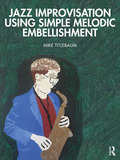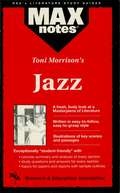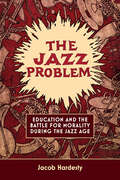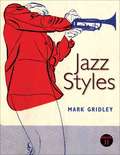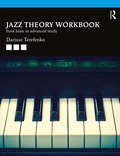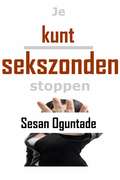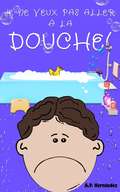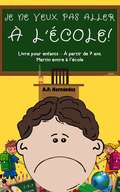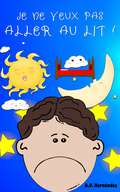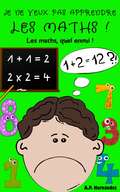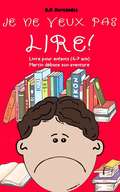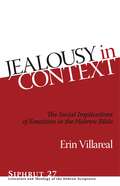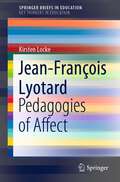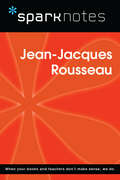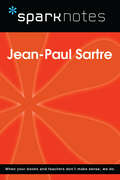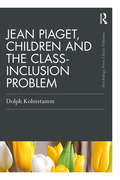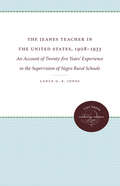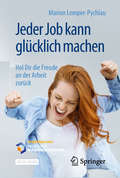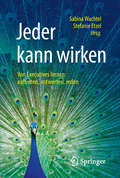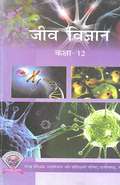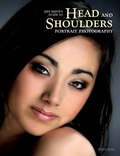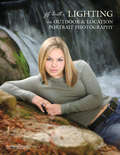- Table View
- List View
Jazz (SparkNotes Literature Guide Series)
by SparkNotesJazz (SparkNotes Literature Guide) by Toni Morrison Making the reading experience fun! Created by Harvard students for students everywhere, SparkNotes is a new breed of study guide: smarter, better, faster. Geared to what today's students need to know, SparkNotes provides: *Chapter-by-chapter analysis *Explanations of key themes, motifs, and symbols *A review quiz and essay topicsLively and accessible, these guides are perfect for late-night studying and writing papers
Jazz Improvisation Using Simple Melodic Embellishment
by Mike TitlebaumJazz Improvisation Using Simple Melodic Embellishment teaches fundamental concepts of jazz improvisation, highlighting the development of performance skills through embellishment techniques. Written with the college-level course in mind, this introductory textbook is both practical and comprehensive, ideal for the aspiring improviser, focused not on scales and chords but melodic embellishment. It assumes some basic theoretical knowledge and level of musicianship while introducing multiple techniques, mindful that improvisation is a learned skill as dependent on hard work and organized practice as it is on innate talent. This jargon-free textbook can be used in both self-guided study and as a course book, fortified by an array of interactive exercises and activities: musical examples performance exercises written assignments practice grids resources for advanced study and more! Nearly all musical exercises—presented throughout the text in concert pitch and transposed in the appendices for E-flat, B-flat, and bass clef instruments—are accompanied by backing audio tracks, available for download via the Routledge catalog page along with supplemental instructor resources such as a sample syllabus, PDFs of common transpositions, and tutorials for gear set-ups. With music-making at its core, Jazz Improvisation Using Simple Melodic Embellishment implores readers to grab their instruments and play, providing musicians with the simple melodic tools they need to "jazz it up."
Jazz (MAXNotes Literature Guides)
by Celeste BullockREA's MAXnotes for Toni Morrison's Jazz MAXnotes offer a fresh look at masterpieces of literature, presented in a lively and interesting fashion. Written by literary experts who currently teach the subject, MAXnotes will enhance your understanding and enjoyment of the work. MAXnotes are designed to stimulate independent thought about the literary work by raising various issues and thought-provoking ideas and questions. MAXnotes cover the essentials of what one should know about each work, including an overall summary, character lists, an explanation and discussion of the plot, the work's historical context, illustrations to convey the mood of the work, and a biography of the author. Each chapter is individually summarized and analyzed, and has study questions and answers.
The Jazz Problem: Education and the Battle for Morality during the Jazz Age
by Jacob W. HardestyThe Jazz Problem shows how high schools and colleges were the primary sites of this generational debate around jazz, the century's first cultural war. Schools were crucial sites of dispute between the worldviews of the late nineteenth century and the emerging modern world, one synonymous with jazz. As a major site of character formation where students came of age, high schools and colleges were the places where jazz was simultaneously celebrated and denigrated. Educators saw jazz as inseparable from other vices, such as smoking, drinking, "immodest dress" (for women), and some degree of sexual activity. Yet young people felt jazz was their music and relished the sense of generational autonomy that came with their affinity for jazz. This book offers a fresh and compelling look at the jazz controversy and how it shaped not only America'“Engaging and interesting to read by a layperson, but also well researched, documented, and written for scholars in the history of jazz, American music, or music education.” — Phillip Hash, School of Music, Illinois State University s musical life but our broader cultural identity.
Jazz Styles: History and Analysis
by Mark C. GridleyThis book was written to help listeners increase their appreciation and enjoyment of jazz. The book and its accompanying Demo CD give readers a peek into how jazz musicians put together performances and how their methods have differed from style to style.
Jazz Theory Workbook: From Basic to Advanced Study
by Dariusz TerefenkoJazz Theory Workbook accompanies the second edition of the successful Jazz Theory—From Basic to Advanced Study textbook designed for undergraduate and graduate students studying jazz. The overall pedagogy bridges theory and practice, combining theory, aural skills, keyboard skills, and improvisation into a comprehensive whole. While the Companion Website for the textbook features aural and play-along exercises, along with some written exercises and the answer key, this workbook contains brand-new written exercises, as well as as well as four appendices: (1) Rhythmic Exercises, (2) Common-Practice Harmony at the Keyboard, (3) Jazz Harmony at the Keyboard, and (4) Patterns for Jazz Improvisaton. Jazz Theory Workbook works in tandem with its associated textbook in the same format as the 27-chapter book, yet is also designed to be used on its own, providing students and readers with quick access to all relevant exercises without the need to download or print pages that inevitably must be written out. The workbook is sold both on its own as well as discounted in a package with the textbook. Jazz Theory Workbook particularly serves the ever-increasing population of classical students interested in jazz theory or improvisation. This WORKBOOK is available for individual sale in various formats: Print Paperback: 9781138334250 Print Hardback: 9781138334243 eBook: 9780429445477 The paperback WORKBOOK is also paired with the corresponding paperback TEXTBOOK in a discounted PACKAGE (9780367321963).
Je kunt sekszonden stoppen
by Sesan OguntadeDit is een praktische christelijke gids over hoe tieners, volwassenen, getrouwde mannen en vrouwen weg kunnen blijven van seksuele zonden. Als je persoonlijk weg wilt blijven van seksuele zonden of als je een tienermeisje hebt dat je graag haar maagdelijkheid wilt behouden, dan zal dit boek je enorm helpen. Getrouwde mannen en vrouwen die hun echtgenoten ontrouw zijn geweest, maar die echt hun wegen willen veranderen, zullen ook van dit boek houden. 30 praktische tips en verhalen over hoe iemand maagd kan blijven, seksuele zonden kan vermijden of stoppen en in volledige harmonie met God kan leven, worden in dit boek besproken. De praktische verhalen van drie personen die bittere lessen hebben geleerd van hun verkeerde gebruik van seks zijn in dit boek gebruikt; je zult genieten en leren van hun verhalen. Het is een andere geweldige christelijke gids over het stoppen van seksuele zonden van de auteur van You Can Stop Masturbation. Grijp vandaag nog jouw exemplaar van You Can Stop Sex Sins.
Je ne veux pas aller à la douche !
by A. P. HernándezDe quoi parle ce livre ? Se doucher est un vrai casse-tête. Martin a découvert que pour prendre une douche, il doit faire beaucoup de choses et que c'est un gros travail. Alors Martin prend une décision : il ne va plus se doucher ! Pourquoi lire ce livre ? Avec les aventures de Martin, les enfants vont réfléchir à l'importance de se laver tous les jours, en reconnaissant qu'une bonne hygiène est essentielle à la santé. Qui peut lire ce livre ? Ce livre, en raison de sa courte durée et de son vocabulaire simple, il est recommandé pour les enfants de 6-7 ans. Il contient également des illustrations qui rendront la lecture plus agréable.
Je ne veux pas aller à l'école!: Livre pour enfants – À partir de 7 ans. Martin entre à l’école
by A. P. HernándezMartin commence l’école mais il ne veut pas y aller. Il préfère rester à la maison et jouer à sa console de jeux vidéos, avec ses peluches et son hélicoptère télécommandé. Après tout, Martin sait beaucoup des choses : il sait compter de un à dix et il sait même que si tu additionnes un jeu vidéo et un autre jeu video, ça donne deux jeux vidéos. Donc, pourquoi devrait-il aller à l’école ? Martin refuser de se lever pour son premier jour d’école. Il s’accroche à la tête de toutes ses forces et sa mère n’arrive pas à le décoller du lit, c’est pourquoi…Martin s’en tire bien ! Il parvient à rester tout seul à la maison toute la journée ! Mais les choses ne sont pas aussi drôles qu’il ne le croie… Un livre pour enfants recommandé à partir de 6-7 ans. Le but de ce livre pour enfants est de favoriser l’imagination des filles et garçons et de faciliter la réflexion sur l’importance d’aller à l’école. Grâce aux aventures de Martin, les garçons et filles apprendront à voir l’école comme un pilier basique dans leur apprentissage et leur développement personnel et social. Je ne veux pas aller à l’école ! est un livre de premier cycle apte à être lu à haute voix aux plus petits. Il est également utile pour que les garçons et filles débutent en tant que lecteurs.
Je ne veux pas aller au lit !: Livre pour enfants de 6 à 9 ans. Martin n'ira pas dormir.
by A. P. HernándezMartin a huit ans et a pris une décision. Il est déterminé. Aujourd’hui, il ne dormira pas ! Et il y parviendra ! Mais le lendemain, des choses étranges commencent à lui arriver. Découvre son histoire ! Un livre recommandé pour les enfants âgés de 6 à 9 ans. L'objectif de ce livre est de démontrer les bienfaits du sommeil réparateur. À travers les aventures de Martin, les enfants apprendront à quel point il est important de dormir pour bien travailler à l'école et mieux vivre. Je ne veux pas aller au lit ! est un livre de premiers apprentissages qui peut être lu à haute voix aux plus jeunes enfants. Il permet également aux enfants de s’initier à la lecture.
Je ne veux pas apprendre les maths !: Livre pour enfants à partir de 6 - 7 ans. Les maths, quel ennui ! (Je ne veux pas... ! #7)
by A. P. HernándezMartin a huit ans et il déteste les maths. A partir de maintenant, il arrête d’apprendre les maths. Fini les additions, les soustractions, les problèmes et tout ce qui va avec. Martin est convaincu que les maths ne servent à rien et qu’elles sont ennuyeuses. Pour autant, sa vie va complètement changer. Un livre pour enfants recommandé aux enfants dès l’âge de 6-7 ans. Ce livre a pour objet de démontrer la présence des mathématiques dans notre quotidien. En suivant les aventures de Martin, les enfants comprendront qu’elles peuvent expliquer et résoudre bien des situations de tous les jours. « Je ne veux pas apprendre les maths ! » est un livre dédié aux premiers apprentissages. C’est le septième livre de la collection de livres pour enfants « Je ne veux pas… ! », dont les autres titres sont : Je ne veux pas lire ! Je ne veux pas aller à l’école ! Je ne veux pas aller me coucher ! Je ne veux pas prendre ma douche ! Je ne veux pas me laver les dents ! Je ne veux pas être privé de téléphone !
Je ne veux pas lire!: Livre pour enfants (6-7 ans). Martin débute son aventure
by A. P. HernándezMartin a huit ans et il déteste lire. Martin vient de terminer l’école et de longues vacances d’été se dessinent devant lui. Mais Joséphine, sa maîtresse, lui a donné tout un paquet de cahiers d’exercices et de fiches à réviser. Mais le pire ce ne sont pas les additions, ni les tables de multiplications et encore moins les photocopies… Joséphine l’a obligé à lire un livre ! Un livre sans dessins, rempli de mots! Un matin, Martin, dans un héroïque acte de bravoure commence à livre le livre. Et ce faisant, des choses extraordinaires commencent à lui arriver… Un livre pour accompagner les plus petits dans leurs premiers apprentissages, pouvant être lu à voix haute. Il est aussi utile afin que garçons et filles fassent leurs premiers pas en tant que lecteurs. Un livre pour enfants recommandé aux jeunes de 6-7 ans. Le but de ce livre pour enfants est de stimuler l’imagination chez les enfants et d'éveiller leur curiosité pour la littérature en les aidant à découvrir qu’il est possible de vivre des aventures et de se divertir à travers les pages d’un livre. Je ne veux pas lire ! est un livre de premiers apprentissages pouvant être lu à voix haute aux plus petits. Il est aussi utile afin que les enfants fassent leurs premiers pas en tant que lecteurs.
Je sais que je peux le faire !
by A. P. HernándezUn conte pour enfants sur l'amitié et le développement personnel. Andrea est un canari très heureux. Sa maîtresse, Églantine, l'aime et prend bien soin de lui. La vie d'Andrea est sereine et paisible, jusqu'à ce qu'un moineau lui rende visite...
Jealousy in Context: The Social Implications of Emotions in the Hebrew Bible (Siphrut)
by Erin VillarealAttested as both a human and a divine expression, the biblical Hebrew term qinʾâ is most often translated as “jealousy” or “envy.” In this study, Erin Villareal makes the case for reading qinʾâ as more than a simple reference to an emotion, instead locating the term’s origins in ancient Israel’s social and legal spheres.Jealousy in Context evaluates the socioliterary context of qinʾâ. Through a series of case studies examining this term as it is applied to residents, sister-wives, brothers, and husbands in biblical narrative passages, Villareal explains that qinʾâ is felt by people who experience a threat or disruption to their rights and status within a social arrangement or community and is therefore grounded in practical concerns that have social and juridical ramifications. Investigating examples of divine qinʾâ, Villareal shows that its social meaning was adapted into theological language about the Israelite deity and his relationship with the people of Israel, and that Yahweh expresses qinʾâ whenever there is a threat to the integrity of his land or his sanctuary. Villareal examines the term through this socioliterary lens to reveal ancient Israelite perceptions concerning social organization and divine-human relationships. Additionally, she explores how the socioliterary character of qinʾâ in the Hebrew Bible communicates representations of ancient Israelite beliefs, values, and social expectations.This convincing new understanding of a key biblical term will be appreciated by students and scholars of the Hebrew Bible, Hebrew linguistics, and ancient Near Eastern societies more generally.
Jean-François Lyotard: Pedagogies of Affect (SpringerBriefs in Education)
by Kirsten LockeThis book gives an introduction to Jean-François Lyotard (1924–1998) as an educational thinker whose philosophical encounters with politics and art offer a radical reconsideration of the aims of education and the nature of pedagogy. The book approaches Jean-François Lyotard’s contributions to educational thought by placing his changing intellectual career within its thematic and pedagogical context. Central chapters deal with Lyotard’s key concepts utilised throughout different phases of his intellectual career, providing new openings and perspectives to an affective form of pedagogy that questions the conditions and perimeters of the educational endeavour as a learning and teaching event. Within these discussions, Lyotard’s ideas about aesthetics and politics receive close attention. The book positions Lyotard’s pedagogical focus within key theoretical concepts traversed in his political and aesthetic writings, exploring his work on the political as an ethical activity, art as resistance, and his later work on childhood and infancy as a state of openness and receptivity.
Jean-Jacques Rousseau: His Thought and its Relevance Today (Routledge Revivals)
by C.H. DobinsonThis book, first published in 1969, is a detailed consideration of Rousseau’s ideas on education, and an examination of how they grew out of his own experiences in childhood. With particular reference to the Confessions and Emile, this book emphasises the practical application of Rousseau’s theories and traces them through each stage of education. Professor Dobinson clearly analyses Rousseau’s views on the general upbringing of children from early infancy to late adolescence, and on the teaching of such subjects as science, history and religion. This book demonstrates throughout the relevance of Rousseau’s thought to the fundamental issues in contemporary education.
Jean-Jacques Rousseau (SparkNotes Philosophy Guide)
by SparkNotesJean-Jacques Rousseau (SparkNotes Philosophy Guide) Making the reading experience fun! SparkNotes Philosophy Guides are one-stop guides to the great works of philosophy–masterpieces that stand at the foundations of Western thought. Inside each Philosophy Guide you&’ll find insightful overviews of great philosophical works of the Western world.
Jean-Paul Sartre (SparkNotes Philosophy Guide)
by SparkNotesJean-Paul Sartre (SparkNotes Philosophy Guide) Making the reading experience fun! SparkNotes Philosophy Guides are one-stop guides to the great works of philosophy–masterpieces that stand at the foundations of Western thought. Inside each Philosophy Guide you&’ll find insightful overviews of great philosophical works of the Western world.
Jean Piaget, Children and the Class-Inclusion Problem (Psychology Press & Routledge Classic Editions)
by Dolph KohnstammThe Classic Edition of Dolph Kohnstamm’s Jean Piaget, Children and the Class-Inclusion Problem, first published in 1967, includes a new introduction by the author, describing for readers the original context for his work, how the field has moved forward and the ongoing relevance of this volume. This enduring text offers a critical study of a cornerstone of Piaget’s theory that a child's ability to solve problems of class-inclusion marks the beginning of the period of concrete (logical) operations at about 7 or 8 years of age. Kohnstamm's experiments show, however, that, with a teaching method that provokes children’s authentic logical thinking processes, most children of 5 can already learn to solve a variety of class-inclusion problems, up to a level where they can even invent similar but new problems themselves. These results question the basic assumption of Piaget's theory that logical operations can only develop in firmly connected groupings of operations. Kohnstamm argues that experimenters must, therefore, show that children who come to master one kind of operation should also show transference to other operations of the same grouping. This insightful volume questions the real existence in brain functioning of Piaget’s families of logical operations. No experimental proof of such families has ever been demonstrated, and thus is solely an assumption in Piaget’s theory. This challenge to Piaget's theory is an invaluable resource for students and scholars of cognitive, developmental and educational psychology.
The Jeanes Teacher in the United States, 1908-1933: An Account of Twenty-Five Years' Experience in the Supervision of Negro Rural Schools
by Lance G. JonesMost educators have heard of the Jeanes Teachers and know something of their work as supervisors of black rural schools in the southern states. The present volume--historical, descriptive, and critical--is an account of the Jeanes movement from its inception down to 1933. Here is an excellent answer to the question of what can be done for Afro-American education in the rural South.Originally published in 1937.A UNC Press Enduring Edition -- UNC Press Enduring Editions use the latest in digital technology to make available again books from our distinguished backlist that were previously out of print. These editions are published unaltered from the original, and are presented in affordable paperback formats, bringing readers both historical and cultural value.
Jeder Job kann glücklich machen: Hol Dir die Freude an der Arbeit zurück
by Marion Lemper-PychlauGlück ist immer eine Eigenleistung. Darum birgt jeder Job trotz aller Widrigkeiten das Potenzial, erheblich zur Erfüllung und Bereicherung des eigenen Lebens beizutragen. Dazu sind Entschlossenheit und Geschick erforderlich, denn Glück braucht Know-how. Die Autorin gibt zahlreiche Hinweise und Tipps, wie jeder Beschäftigte auf seine ganz eigene Weise jeden Tag, an jedem Arbeitsplatz selbstverantwortlich freudvolle Momente entstehen lassen kann.Zugleich wendet sich die Expertin für Arbeitsfreude gegen die Konzepte der unablässigen Selbstmotivierung und Zweiteilung nach der Work-Life-Balance. Sowohl Arbeit wie Freizeit sind wertvolle Lebenszeit. Deshalb gilt es, auch das Glückspotenzial der Arbeit auszuschöpfen und die Arbeit genau wie die Freizeit mit allen Kräften zu genießen.
Jeder kann wirken: Von Executives lernen: auftreten, antworten, reden
by Sabina Wachtel Stefanie Etzel Kerstin KöhlerErfahren Sie, warum und wie Spitzenmanager und Politiker in Gespräch und Vortrag so gut wirken und sich in Diskussionen immer wieder durchsetzen. In diesem Buch verraten Autoren, die als Experten mit den Auftritten exponierter Personen in Wirtschaft, Politik und Gesellschaft zu tun haben, wie diese sich darauf vorbereiten bzw. vorbereitet werden und was weniger Prominente für ihr Auftreten auf der Bühne des Lebens davon nutzen können. Ob beim ersten Date oder einem Job-Interview, der Dinnerspeech zur Hochzeit des besten Freundes oder einer Präsentation vor dem Vorstand: Wenn es darauf ankommt, will man die beste Wirkung entfalten. Das lässt sich von den Profis lernen: gut auftreten, antworten, reden und einfach besser 'rüberkommen – Executive Communication für alle.
Jeev Vigyan class 12 - S.C.E.R.T Raipur - Chhattisgarh Board: जीव विज्ञान कक्षा 12 - एस.सी.ई.आर.टी. रायपुर - छत्तीसगढ़ बोर्ड
by Rajya Shaikshik Anusandhan Aur Prashikshan Parishad Raipur C. G.जीव विज्ञान कक्षा 12 वी का राज्य शैक्षिक अनुसंधान और प्रशिक्षण परिषद् छत्तीसगढ़ रायपुर ने पुस्तक हिंदी भाषा में प्रकाशित किया गया है, इस पाठपुस्तक में सौलाह अध्याय दिये गये है, जिसमे हर अध्याय के विवरण कि व्याख्या कि गई है और इस पाठपुस्तक में चित्र कि सहायता से हर भाग का विस्तुर्त रूप मे विवरण किया गया जिससे विद्यार्थीयो को समझने मे आसानी होगी ।
Jeff Smith's Guide to Head and Shoulders Portrait Photography
by Jeff SmithWith detailed, informative instructions for capturing personable and memorable yearbook photos, actor and model portfolios, and business, bridal, and children's portraits, this exhaustive reference covers what photographers need to know to be successful. Emphasizing that the client is always the center of the photograph, this resource illustrates how to evaluate the customer to determine which features to downplay and which to accent. Tips for creating the perfect image through posing and lighting, handling the post-shot conference, and previewing and retouching the images are supplied, as well as guidance for the technical and emotional challenges of shooting a portrait. Packed with step-by-step images, no-nonsense techniques, and practical advice, this is a must-have book for professional and advanced amateur photographers.
Jeff Smith's Lighting for Outdoor & Location Portrait Photography
by Jeff SmithShattering the notion that location lighting has to be difficult, inconvenient, or compromised in its quality, this resource provides guidance on how to create unique and personalized images shot in parks, on city streets, at sports arenas, in workplaces, or in a client’s home. With an overview of equipment and a discussion on the essential tools for a shoot, this guide walks photographers through the creation of dozens of location images#151;from casual headshots to full-length, formally posed portraits. With strategies for meeting lighting challenges found outside of the studio#151;from evaluating existing light to modifying or supplementing light as needed#151;this book will help photographers shoot confidently by developing a plan for creating professional-quality location portraits.

